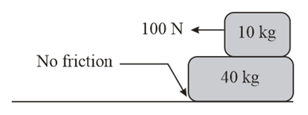Two-Block Problems
Two-Block Problems: Overview
This topic covers concepts such as Motion of Two Blocks on Inclined Plane, Motion of Two Blocks on Horizontal Plane, Condition for Relative Motion between Two Blocks, and Motion of Two Blocks in Contact.
Important Questions on Two-Block Problems
Two blocks connected by a massless string slide down an inclined plane having an angle of inclination of The masses of the two blocks are and respectively and the coefficients of friction of and with the inclined plane are 0.75 and 0.25 respectively. Assuming the string to the taut, find the tension in the string.
Two blocks connected by a massless string slide down an inclined plane having an angle of inclination of The masses of the two blocks are and respectively and the coefficients of friction of and with the inclined plane are and respectively. Assuming the string to be taut, find the common acceleration of two masses.
In the arrangement coefficient of friction between the two blocks is . The force of friction acting between the two blocks is:

A man sitting in a train in motion is facing the engine. He tosses a coin up, the coin falls behind him. The train is moving
A single horizontal force F is applied to a block of mass , which is in contact with another block of mass (Given figure). If the surfaces are frictionless, the force between the blocks is

Two blocks of masses and are placed on a horizontal surface as shown in fig. The coefficient of friction between the blocks is and that between the block and the horizontal surface is . What is the maximum horizontal force that can be applied to block so that the two blocks move without slipping ? Take
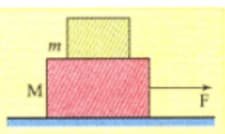
Blocks and are arranged as shown in the figure. The pulley is frictionless. The mass of is . The coefficient of friction between the block and the horizontal surface is . The minimum mass of , to start the motion, will be
In the arrangement shown in the figure, if the blocks of masses and are released from the state of rest, tension in the string is ( coefficient of friction, string is massless and inextensible, pulley is frictionless)
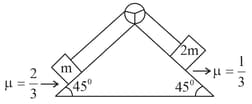
In the situation shown, the reading of the spring balance is

If force is applied to block as shown in diagram then maximum value of so that there is no relative motion between the blocks.

Calculate the accelerations of the blocks and

A force of is applied on the upper block as shown in figure. The coefficient of static friction between the two blocks is and that between the lower block and the surface is zero. The work done by the lower block on the upper block for a displacement of of the upper block is :-

In friction is present between only and limiting friction between . Find acceleration of

In the given arrangement of a doubly inclined plane two blocks of masses and are placed. The blocks are connected by a light string passing over an ideal pulley as shown. The coefficient of friction between the surface of the plane and the blocks is . The value of , for which will move down with an acceleration of , is : (take and )
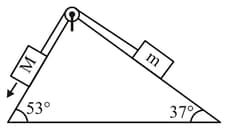
A block of mass sits on the top of a block of mass which sits on a table. The coefficient of kinetic friction between all surface is . A massless string is connected to each mass and wraps halfway around a massless pulley, as shown. Assume that you pull on the pulley with a force of . The acceleration of your hand is -

Two blocks of masses and are placed one over the other as shown in the figure. The coefficient of friction between and is and between and ground is . If a horizontal force is applied on the upper block and is the tension developed in the string, then choose the incorrect alternative.
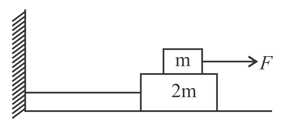
In the figure, and . For what minimum value of force , starts slipping over
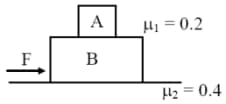
Two blocks and are placed one over the other on a smooth horizontal surface. The maximum horizontal force that can be applied on the lower block so that and move without separation is . The coefficient of friction between and is ( take )

Two blocks masses 1 kg and 2 kg rest on a smooth horizontal table. When the 2 kg block is pulled by a certain force , the tension in the string is 1.5 N. The value of is

A slab rests on a frictionless floor. A block rests on top of the slab. The static coefficient of friction between the block and the slab is while the kinetic coefficient of friction is . The block is acted upon by a horizontal force of . If , the resulting acceleration of the slab will be
